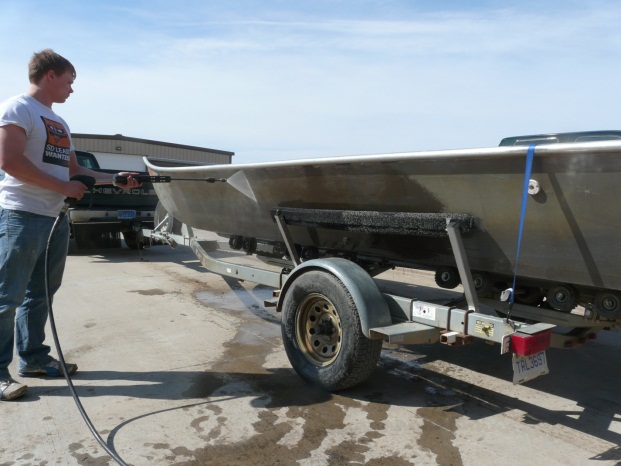
Boat ownership doesn’t stop at the hull. If you use a trailer to transport your boat or regularly launch from concrete ramps, you’ve probably seen how quickly they accumulate grime, algae, salt, and rust. Left unchecked, these build-ups can cause corrosion, reduce traction, and even pose safety hazards.
The good news? Power washing is one of the easiest and most effective ways to maintain your boat trailer and launch ramp—and you don’t need to be a pro to do it.
This guide will break down how to properly pressure wash your trailer and the ramps you use, all while protecting your gear and the environment. 🌊🧽
🧭 Why Power Wash Boat Trailers and Launch Ramps?
Both trailers and ramps are constantly exposed to:
- Saltwater and brackish water
- Moss, algae, and barnacles
- Sand, grit, and mud
- Oil or fuel stains
- Corrosive road salt (from towing in winter)
Cleaning them isn’t just cosmetic—it’s essential for safety, equipment longevity, and environmental health.
🧰 Equipment You’ll Need
- Pressure washer (minimum 2,000 PSI for ramps; 1,500+ for trailers)
- 15° or 25° nozzle tip
- Marine-safe degreaser or soap
- Long-handled scrub brush
- Rust-remover spray (optional)
- Safety gear (gloves, glasses, waterproof boots) 🥾🧤
- Drop cloths or containment mats (if cleaning on land)
Browse Amazon Here For Top Rated Power Washers And Accessories
🛠️ How to Pressure Wash a Boat Trailer
Your trailer hauls a heavy load—give it the attention it deserves:
1️⃣ Rinse Immediately After Use
Especially after saltwater launches, rinse your trailer as soon as possible to reduce corrosion risk. If you’re not at home, use a hose at the marina to spray off wheels, frame, and hitch.
2️⃣ Prep for Deep Cleaning
- Park the trailer on a gravel or paved surface
- Remove the boat if possible
- Inspect for rust, flaking paint, or grease buildup
- Cover or avoid lights, wiring harnesses, and winches
3️⃣ Apply Cleaner
Use a marine-safe degreaser or diluted dish soap:
- Apply with the washer’s soap nozzle or spray bottle
- Let it sit for 5–10 minutes to loosen grime
- Avoid letting soap dry on the metal
4️⃣ Scrub Tough Spots
Use a stiff brush on:
- Fenders
- Axle housing
- Wheel hubs
- Bunk brackets
These areas trap sand and algae the most.
5️⃣ Pressure Wash Thoroughly
Use a 25° nozzle to clean most surfaces, switching to 15° for tires or very dirty areas. Stay at least 12 inches away to prevent chipping paint or seals.
Focus on:
- Tongue and hitch assembly
- Cross members
- Tire wells
- Undercarriage
6️⃣ Dry and Protect
Let the trailer air dry, or towel dry with a microfiber cloth.
Once dry, consider:
- Applying a rust inhibitor
- Spraying silicone lube on moving parts
- Inspecting tires for cracks or embedded debris
🧠 Tip: Always grease your bearings after cleaning—water exposure can push out the lubricant.
🧱 How to Power Wash a Boat Launch Ramp
Boat launch ramps can get dangerously slick if not cleaned. Algae and moss create a slip hazard for both boaters and vehicles.
1️⃣ Safety First
- Wear waterproof non-slip boots 🥾
- Check the tide schedule if on a tidal ramp
- Use traffic cones to block off area if public
2️⃣ Remove Surface Debris
Use a broom or leaf blower to clear sand, sticks, or trash before pressure washing. This prevents clogging your washer or smearing dirt.
3️⃣ Choose the Right Pressure and Tip
Use a pressure washer with at least 2,000 PSI and a 15° tip for concrete. You may need a surface cleaner attachment for wide areas.
4️⃣ Spray Methodically
- Start from the top of the ramp, moving downward
- Use overlapping horizontal passes
- Focus on algae-covered areas and wheel grooves
- Rinse the edges last to push debris away from clean zones
5️⃣ Clean Up Runoff
Use containment mats or booms if runoff could reach storm drains or sensitive areas. Most marinas and public ramps have local rules—check before cleaning.
❌ What NOT to Do
- ❌ Don’t use bleach near water sources
- ❌ Don’t pressure wash hot metal (let trailer cool first)
- ❌ Don’t spray directly at seals or wiring
- ❌ Don’t clean ramps at low tide (you’ll stir up sediment)
🌎 Eco-Friendly Tips
Because boat gear is often cleaned near water:
- Use biodegradable soaps labeled “marine-safe”
- Avoid petroleum-based degreasers
- Minimize water use with lower-GPM settings
- Catch runoff where possible
🗓️ Maintenance Schedule
| Task | Frequency |
|---|---|
| Rinse trailer | After each launch |
| Deep clean trailer | Monthly or after saltwater use |
| Power wash ramp | Every 1–2 months (or when algae appears) |
| Rust prevention | Every 2–3 months |
💬 Final Thoughts
Whether you’re trailering your boat across states or just down the road, keeping your trailer and ramp clean is about more than looks—it’s about performance, longevity, and safety.
Power washing makes it easy to remove the grime, algae, and buildup that can eat away at your investment over time. With a few basic tools and a regular routine, your trailer will last longer and your launch experience will stay smooth and slip-free. 🚤🧽✨
Browse Amazon Here For Top Rated Power Washers And Accessories



